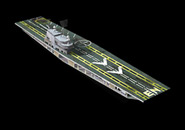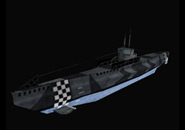 |
The Bismarck
The sinking of the German battleship Bismarck is one of the best-known WWII naval stories. Sent by the Germans to harass allied shipping in the North Atlantic, the Bismarck was spotted off the coast of Norway by a British plane on May 18, 1941. The British immediately dispatched ships to intercept it, including the H.M.S. Prince of Wales and, the pride of the Royal Navy, the H.M.S. Hood. The British force caught up to the battleship near Iceland on May 24. In the ensuing battle, the Prince of Wales sustained heavy damage and the Hood was sunk with a loss of 1,416 men - all but three of her entire complement. The Bismarck escaped with only light damage. More British ships arrived, including the aircraft carrier Victorious. After another skirmish, in which British torpedo bombers scored one hit that killed a crewmember but did minimal damage, the Bismarck again slipped away. The British lost contact with the German battleship on May 25. The Bismarck was not spotted again until the next day. Naval groups from the West and North set off in pursuit while more British warships approached from the South. Late on May 26, repeated attacks by torpedo bombers finally scored two hits on the Bismarck, one in the rear, which jammed the rudder. As a result, the Bismarck lost maneuverability and drifted toward the British fleet. The next morning, the British closed in. The battleships Rodney and King George V opened fire at 0847 hours. The Bismarck fired back but, unable to steer, proved an easy target. Within half an hour, the Bismarck suffered multiple direct hits that destroyed several turrets, took out the fire-control center and killed most of the senior officers. The British warships continued to pound the Bismarck, which fired its last ineffective salvo at 0931. With the once-mighty battleship now little more than a floating hulk, the surviving crew set scuttling charges. The British cruiser Dorsetshire moved in and fired several torpedoes, which exploded at about 1030. The Bismarck finally capsized and sank at about 1040 hours on May 27, 1941. Only 115 sailors of a crew of over 2,000 survived.
In June, 1989, an expedition discovered the wreck of the Bismarck 600 miles off the coast of France in 15,000 feet of water.
U.S.S. Enterprise (the Big E) CVN-65
Many ships have proudly carried the Enterprise name, which can be traced back to a British supply sloop that was captured during the American Revolution. The seventh Enterprise (CV-6) was the first aircraft carrier to bear the name and is famous for its role at the Battle of Midway and other naval engagements in the World War II Pacific Theater. The eighth U.S.S. Enterprise (CVN-65) was the first nuclear-powered aircraft carrier. Like its predecessor, it has had a distinguished career. In February 1962, the carrier acted as a tracking station for the Friendship 7, the United States' first orbital spacecraft, piloted by Lieutenant Colonel John Glenn. In October 1962, the Enterprise participated in the naval blockade of Cuba during the Cuban Missile Crisis. The Big E made six deployments to Southeast Asia from 1965 to 1972, becoming the first nuclear-powered ship to engage in combat. She was also the first carrier to deploy the F-14A "Tomcat" and assisted with the 1975 evacuation of Saigon.
The Enterprise has undergone several refits, the most extensive of which concluded in 1994. She is expected to remain in service well into the 21st century.
U-Boat (Type VIIB)
German submarines, or "U-boats," took a heavy toll on Allied shipping in both World War I and World War II. A number of designs were put into production to fill various roles. The Type VIIB U-boat was a very successful attack-sub during World War II. The VIIB carried more fuel and was a bit faster than its predecessor, the Type VIIA, and also had a second rudder for better maneuverability. Like the VIIA, the VIIB was armed with four torpedo tubes in the bow and one aft, but it carried three additional torpedoes, for a total of 14. Twenty-four VIIB U-boats were built from 1936 to 1940, when the slightly larger VIIC went into production.
U-48, the most successful U-boat of the war, was a Type VIIB. Commissioned in April 1939, she sank 52 ships and damaged four more, for total loss of more than 300,000 tons of shipping. U-48 was scuttled in May 1945, as part of Operation Regenbogen, to keep the German fleet from falling into the hands of the Allies at the end of the war.
U.S.S Warrington DD-843
The Warrington (DD-843) was a Gearing-class Destroyer, commissioned just after the end of WWII. It was the third U.S. warship given the name Warrington. Outfitted with surface guns, anti-aircraft guns, torpedoes and depth charges, the Warrington was a versatile and formidable vessel capable of taking on many assignments.
She went through an extensive refit in 1961-62 and became a guided-missile destroyer used primarily in an anti-submarine role. The Warrington was deployed during the Cuban Missile Crisis, where it fired a warning shot to stop a Russian ship heading for Cuba. She was also on hand after the atomic sub USS Thresher was tragically lost with all hands in 1963. When on duty during the Vietnam War in 1972, the Warrington struck a mine in the Tonkin Gulf under somewhat suspicious circumstances. The ship was decommissioned and sold to Taiwan for scrapping in 1973.
|
||||||||||||||||||||||||||||||||||||||||||






